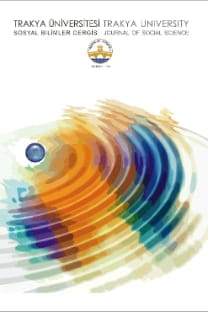Kelebek şeklinde dağılan artıklar için genel varyans dengeleme yöntemlerinin karşılaştırılması
Comoaring general variance stabilizing methods for butterfly distributed residuals
___
- Aitkin, M., “Modelling Variance Heterogeneity in Normal Regression Using GLIM”, Applied Statistics, 36, pp. 332-339, 1987.
- Albayrak, A. S., “Değişen Varyans Durumunda En Küçük Kareler Tekniğinin Alternatifi Ağırlıklı Regresyon Analizi ve Bir Uygulama”, Afyon Kocatepe Üniversitesi, İ.İ.B.F. Dergisi (C.X ,S II) ,s. 111-138, 2008.
- Basu, A., “Extended generalized linear models:Simultaneous estimation of flexible link an variance functions” The Stata Journal, N 4, pp. 501-516, 2005.
- Bischoff, W., Heck, B., Howind, J., Teusch., A., “Aprocedure for estimating the variance function of linear models and for checking the appropriateness of estimated variances a case study of GPS carrier-phase observations”, J Geod., 79, 694–704, 2006.
- Box, G. E. P. and Cox, D. R., “An analysis of transformations (with discussion)”, Journal of the Royal Statistical Society, series B, 26, 211–246, 1964.
- Carroll, R.J., Ruppert, D., Transformation and Weighting in Regression, Chapman and Hall, 1988.
- Chatterjee, S., Machler, M., “Robust Regression: A Weighted Least Squares Approach”, Commun. Statist.-Theory, 26(6), 1381-1394, 1997.
- Darlington, R. B., “Correcting the standard errors of regression slopes for heteroscedasticity,” http://www.psych.cornell.edu/darlington/heterosc.htm (1997).
- Friel, C., M., Weighted Least-squares Regression, Houston State University, 2009.
- Hamasaki, T. and Goto ,M., “Power-Transformatıon Model to Additıvity in Regression”, Behaviormetrika, Vol.32, No.2, 111–125, 2005.
- Gujaratti, D., Basic Ekonometrics, 2001.
- Güriş, S. ve Çağlayan, E., 2001. Ekonometri, Der Yayınları, 2001.
- Harvey, A.C., “Estimating Regression Models with Multipcative Heteroskedasticity”, Ekonometrica, 44, 461-465, 1976..
- Meloun, M., Militky, J., Kupka, K., Brereton, R.G.,. “The effect of influental data, model and method on the precision of univariate calibration”, Talanta, 57, 721-740, 2002.
- Oberg, A. and Davidian, M., “ Estimating Data Transformations in Nonlinear Mixed Effects Models”, Biometrics 56, 65-72, 2000.
- Pardoe, I. and Cook, D., “ A Graphical Diagnostic For Variance Functions” Aust.& N. Z. J. Stat. 49(3), 241–250, 2007.
- PBC Electronics Designing, “The fixed geometry structure’s FFT algorithm and FPGA realize-www.51rd.net”, 2009.
- SAS/IML 9.2 User’s Guide,. SAS Institute Inc., Cary, NC, USA, 2008.
- Sümer, K. K., “White’ın Heteroskedastisite Tutarlı Kovaryans Matrisi Tahmini Yoluyla Heteroskedastisite Altında Model Tahmini”, İstanbul Üniversitesi İktisat Fakültesi Ekonometri ve İstatistik Dergisi, Sayı 4 2006- 12-28.
- http://www.rshm.saglik.gov.tr/hki/hkindex/index5.htm
- http://www.havaizleme.com/r.html
- ISSN: 1305-7766
- Yayın Aralığı: Yılda 2 Sayı
- Başlangıç: 2000
- Yayıncı: Trakya Üniversitesi Sosyal Bilimler Enstitüsü
BİR KRİZ FAKTÖRÜ OLARAK TAŞIMA KAPASİTESİ AŞIMI VE BOZCAADA ÖRNEĞİ
Rıght to information in Turkey in the scope of accontability
1990'LARDA TÜRKİYE-ABD İLİŞKİLERİNDE SEİA ve ABD YARDIMI
The sentiments of adam smith relating to economic growth as an inspirer to modern growth theories
OYUN BECERİLERİ DEĞERLENDİRME ÖLÇEĞİNİN GEÇERLİK VE GÜVENİRLİK ÇALIŞMASI
Yeşim FAZLIOĞLU, Gökhan ILGAZ, Erdal PAPATĞA
ETKİLİ ÖĞRETMEN ÖZELLİKLERİ ÜZERİNE SIRALAMA YÖNTEMİYLE BİR ÖLÇEKLEME ÇALIŞMASI
Metin ÖZKAN, H. İsmail ARSLANTAŞ
ERASMUS PROGRAMININ TÜRKİYE ÜNİVERSİTELERİ VE ÜNİVERSİTE ÖĞRENCİLERİ ÜZERİNDEKİ ETKİLERİ
Kelebek şeklinde dağılan artıklar için genel varyans dengeleme yöntemlerinin karşılaştırılması
TÜRKİYE ‘DE HESAPVERİLEBİLİRLİK BAĞLAMINDA BİLGİ EDİNME HAKKI
